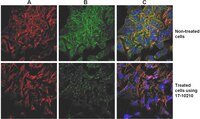Absence of ataxin-3 leads to cytoskeletal disorganization and increased cell death.
Ana-João Rodrigues,Maria do Carmo Costa,Teresa-Luísa Silva,Daniela Ferreira,Fernanda Bajanca,Elsa Logarinho,Patrícia Maciel
Biochimica et biophysica acta
1803
2010
Show Abstract
Ataxin-3 (ATXN3) is a widely expressed protein that binds to ubiquitylated proteins, has deubiquitylating activity in vitro and is thought to modulate substrate degradation through the ubiquitin-proteasome pathway. Expansion of a polyglutamine tract in ATXN3 causes Machado-Joseph disease, a late-onset neurodegenerative disorder characterized by ubiquitin-positive aggregate formation and specific neuronal death. Although ATXN3 has been involved in transcriptional repression and in the ubiquitin-proteasome pathway, its biological function is still unknown. In this work, we show that depletion of ATXN3 using small-interference RNA (siRNA) causes a prominent phenotype in both human and mouse cell lines. A mild increase in ubiquitylation occurs and cells exhibit ubiquitin-positive foci, which is consistent with ATXN3 putative function as a deubiquitylating enzyme. In addition, siATXN3-silenced cells exhibit marked morphological changes such as rounder shape and loss of adhesion protrusions. At a structural level, the microtubule, microfilament and intermediate filament networks are severely compromised and disorganized. This cytoskeletal phenotype is reversible and dependent on ATXN3 levels. Cell-extracellular matrix connection is also affected in ATXN3-depleted cells as talin expression is reduced in the focal adhesions and lower levels of alpha-1 integrin subunit are expressed at their surface. Although the cytoskeletal and adhesion problems do not originate any major change in the cell cycle of siATXN3-depleted cells, cell death is increased in siATXN3 cultures compared to controls. In summary, in this work we show that the absence of ATXN3 leads to an overt cytoskeletal/adhesion defect raising the possibility that this protein may play a role in the cytoskeleton. | 20637808
 |









